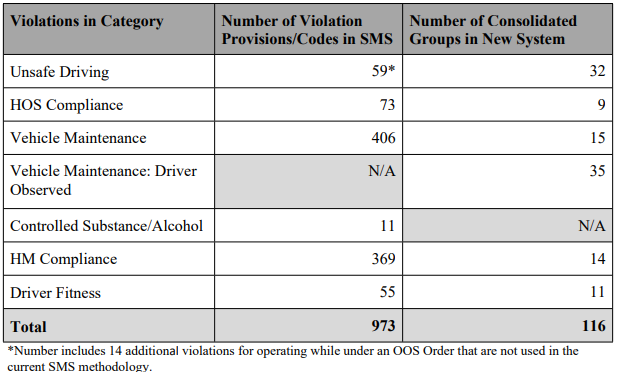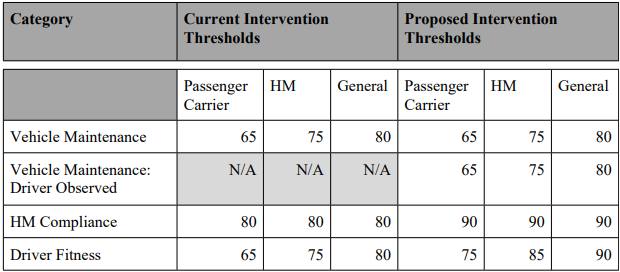Furry Friends Cause Trucking Border Delays At Canadian Border
To prevent reintroduction of rabies carried by dogs into the United States, new CDC regulations require proof of healthy pets at border crossing. Truckers who
We are a team of DOT Compliance and Licensing Professionals helping trucking and transportation companies remain safe, compliant, and profitable.
CNS or Compliance Navigation Specialists is DOT Compliance company that assists trucking and transportation companies remain DOT Compliant. We are part of a network of companies, CNS Companies, specializing in services related to the transportation, manufacturing, construction, service, education and medical industries.

A full-scale DOT Compliance Program managing a long haul carrier’s safety, compliance, licensing and more.
Learn more >>>
A DOT Compliance Program that keeps motor carriers compliant with the 6 Basic DOT Regulations required of all carriers.
Learn more >>>
Our Short-Haul/Construction Program is a full-scale program designed for private carriers that do not haul for-hire.
Learn more >>>
Our most comprehensive DOT Compliance Program, operating as your company’s off-site Safety Director or assisting your current safety personnel.
Learn more >>>
Our Non-CDL Program is a full-scale program managing safety, compliance, licensing and more for moving companies, couriers, landscapers, or any company subject to DOT regulations and does not employ CDL drivers.
Learn more >>>
Our DOT Audit Services cover a number of different types of DOT Audits that new and existing carriers will be subject to.
Our DOT Driver Services help trucking companies and carriers to stay compliant as they grow and hire more drivers.
Our DOT Vehicle Services focus on ensuring your vehicles are compliant with DOT Regulations, which is just as important as your drivers.
Our DOT Services for Special Carriers focus on companies outside of the typical motor carrier, like HAZMAT, Passenger and Bus Carriers.
CNS is part of a group of companies that offer other necessary services for the trucking and transportation industry, such as Commercial Trucking Insurance, CDL Training, Online Training Course, and even Healthcare.
Our DOT Licensing Services will cover you whether you are an existing company or just starting a trucking company. Our DOT Licensing Specialists can help you get up and running and in days with your DOT number, MC Authority, EIN, UCR, IFTA, 2290 HVUT, Fuel Taxes and can even set you up to get your Commercial Driver's License (CDL) with CNS Driver Training Center.
Our DOT Licensing Specialists will help you with every aspect of starting a trucking company. All you need to do is choose a name for your trucking company.
You will need to ensure your DOT Number, MC Authority, Vehicle Registration, etc. is all set up properly when you start your trucking business.
Our Licensing Specialists can help with all aspects of filing and renewing licenses, fuel taxes, etc.
CNS is part of a group of companies that offer other necessary services for the trucking and transportation industry, such as Commercial Trucking Insurance, CDL Training, Online Training Course, and even Healthcare.
To prevent reintroduction of rabies carried by dogs into the United States, new CDC regulations require proof of healthy pets at border crossing. Truckers who
CNS or Compliance Navigation Specialists is DOT Compliance company that assists trucking and transportation companies remain DOT Compliant. We are part of a network of companies, CNS Companies, specializing in services related to the transportation, manufacturing, construction, service, education and medical industries.
CNS Companies is a network of companies specializing in services related to the transportation, manufacturing, construction, service, education and medical industries. Our DOT Compliance division is handled by Compliance Navigation Specialists, CNS Insurance handles Commercial Truck Insurance, CDL training is managed by the CNS Driver Training Center and healthcare is managed by CNS Occupational Medicine.
We are a team of DOT Compliance and Licensing Professionals helping trucking and transportation companies remain safe, compliant, and profitable.
CNS or Compliance Navigation Specialists is DOT Compliance company that assists trucking and transportation companies remain DOT Compliant. We are part of a network of companies, CNS Companies, specializing in services related to the transportation, manufacturing, construction, service, education and medical industries.

A full-scale DOT Compliance Program managing a long haul carrier’s safety, compliance, licensing and more.
Learn more >>>
A DOT Compliance Program that keeps motor carriers compliant with the 6 Basic DOT Regulations required of all carriers.
Learn more >>>
Our Short-Haul/Construction Program is a full-scale program designed for private carriers that do not haul for-hire.
Learn more >>>
Our most comprehensive DOT Compliance Program, operating as your company’s off-site Safety Director or assisting your current safety personnel.
Learn more >>>
Our Non-CDL Program is a full-scale program managing safety, compliance, licensing and more for moving companies, couriers, landscapers, or any company subject to DOT regulations and does not employ CDL drivers.
Learn more >>>
Our DOT Audit Services cover a number of different types of DOT Audits that new and existing carriers will be subject to.
Our DOT Driver Services help trucking companies and carriers to stay compliant as they grow and hire more drivers.
Our DOT Vehicle Services focus on ensuring your vehicles are compliant with DOT Regulations, which is just as important as your drivers.
Our DOT Services for Special Carriers focus on companies outside of the typical motor carrier, like HAZMAT, Passenger and Bus Carriers.
CNS is part of a group of companies that offer other necessary services for the trucking and transportation industry, such as Commercial Trucking Insurance, CDL Training, Online Training Course, and even Healthcare.
Our DOT Licensing Services will cover you whether you are an existing company or just starting a trucking company. Our DOT Licensing Specialists can help you get up and running and in days with your DOT number, MC Authority, EIN, UCR, IFTA, 2290 HVUT, Fuel Taxes and can even set you up to get your Commercial Driver's License (CDL) with CNS Driver Training Center.
Our DOT Licensing Specialists will help you with every aspect of starting a trucking company. All you need to do is choose a name for your trucking company.
You will need to ensure your DOT Number, MC Authority, Vehicle Registration, etc. is all set up properly when you start your trucking business.
Our Licensing Specialists can help with all aspects of filing and renewing licenses, fuel taxes, etc.
CNS is part of a group of companies that offer other necessary services for the trucking and transportation industry, such as Commercial Trucking Insurance, CDL Training, Online Training Course, and even Healthcare.
To prevent reintroduction of rabies carried by dogs into the United States, new CDC regulations require proof of healthy pets at border crossing. Truckers who
CNS or Compliance Navigation Specialists is DOT Compliance company that assists trucking and transportation companies remain DOT Compliant. We are part of a network of companies, CNS Companies, specializing in services related to the transportation, manufacturing, construction, service, education and medical industries.
CNS Companies is a network of companies specializing in services related to the transportation, manufacturing, construction, service, education and medical industries. Our DOT Compliance division is handled by Compliance Navigation Specialists, CNS Insurance handles Commercial Truck Insurance, CDL training is managed by the CNS Driver Training Center and healthcare is managed by CNS Occupational Medicine.

Love is NOT in the air for SMS safety scores to change to an Item Response Theory model.
In 2017, it was suggested that the FMCSA should radically improve the CSA system with the highly complex Item Response Theory (IRT) model.
However, according to FMCSA’s recent notice, they will not adopt this model but make many changes to the existing SMS system.
There is a lot to break down here, so let’s look at what was cut and what changes are coming.
Don’t forget you can comment in the next 90 days on the FMCSA website.
A Congress-mandated report by the National Academies of Science issued recommendations that the U.S. Department of Transportation overhaul its Compliance, Safety, Accountability (CSA) carrier rating system.
At the time, the report criticized that some BASICs lacked correlation with:
The report also offered several recommendations that FMCSA should:
[Related: Carriers Must Go Digital to Meet Future Off-Site Audit Expectations]
However, FMCSA found many issues in the testing and models of the IRT approach.
FMCSA’s IRT modeling work revealed many limitations and practical challenges with using an IRT model.
As a result, FMCSA has concluded that IRT modeling does not perform well for the Agency’s use in identifying motor carriers for safety interventions, and therefore, does not improve overall safety.
Here were the reasons why:
[Related: Best DOT Audit Guide in the Industry]
FMCSA proposes the following combined improvements to SMS:
Let’s break these down.
Reorganizing Safety Categories (BASICs)
Your CSA scores are based on multiple factors called Behavioral Analysis and Safety Improvement Categories or “BASIC” categories. Roadside inspection violations, as well as investigation results, fall under 1 of 7 categories, including:
The proposed changes would make the new safety categories:
Controlled Substances/Alcohol has the fewest violations of any BASIC, and those violations are also cited relatively infrequently.
The EFA demonstrated that controlled substances and alcohol violations were strongly associated with the Unsafe Driving BASIC and supported removing the Controlled Substances/Alcohol category as a standalone BASIC.
The new Unsafe Driving safety category now includes the drug and alcohol violations that were previously captured in the Controlled Substances/Alcohol BASIC.
In addition, violations for operating while under an OOS Order belong in the new Unsafe Driving safety category.
Currently, SMS places these types of violations across multiple BASICs based on the underlying OOS violation. Moving and consolidating these violations to the new Unsafe Driving safety category would allow motor carriers and enforcement officials to more effectively identify and correct driver-based safety problems related to disregarding OOS Orders.
Vehicle Maintenance is the largest BASIC in terms of both the number of violation identifiers included in the BASIC and the number of violations cited during inspections.
Breaking this category into two separate categories would provide greater specificity to help carriers improve and enforcement officials to conduct targeted investigations.
Consolidated Violations and Severity Weights
FMCSA’s analysis during IRT modeling confirmed that similar violation provisions could be consolidated to mitigate differences that result from inspectors citing different violation codes. Grouping similar violations together would also allow motor carriers and enforcement officials to identify and address specific safety issues more easily. The following table shows a summary of the consolidated violations by safety category.

SMS assigns each violation a specific severity weight that is intended to correlate with the crash risk associated with that violation.
FMCSA proposes to simplify violation severity weights by assigning each consolidated violation group a weight of either one or two.
FMCSA’s evaluation found that simplifying the severity weights identifies carriers with higher crash rates. This change would maintain the safety focus on those violations severe enough to result in an OOS Order while removing the subjectivity and complications of distinguishing each violation by severity on a scale of 1 through 10.
Proportionate Percentiles
FMCSA places motor carriers into safety event groups in SMS based on their number of inspections and crashes. For example, carriers in the HOS Compliance BASIC with 3 to 10 driver inspections are compared to each other, while carriers with 11 to 20 driver inspections are compared to each other, and so forth.
When a carrier moves into a different safety event group, they sometimes experience large percentile jumps based solely on a no-violation inspection in this new safety group.
FMCSA proposes to smooth out the groups with median benchmarks to prevent these sudden jumps in percentiles.
Intervention Thresholds
The FMCSA sends warning letters when safety performance data indicates they are not complying with safety regulations.
The BASIC “intervention thresholds” were established because they are strong indicators of future crash risk and exceeding them can put you on FMCSA’s priority lists which can later result in fines and violations.
FMCSA’s found that the Driver Fitness and HM Compliance safety categories have the lowest correlation to crash risk and believes raising the Intervention Thresholds in those safety categories would allow the Agency to focus on populations with a greater safety risk.

While most of these changes to the SMS system sounds fair, it will shake up and impact carriers that were previously close to an investigation threshold.
This may mean you will be targeted more heavily than before.
Are you prepared for a DOT Audit?
There is no question that you will go through a DOT Audit, the question is will you pass a DOT Audit. Our DOT Compliance team is available to help with any type of audit, including New Entrant Audits, DOT Compliance Reviews, Focused Reviews, IFTA Audits or IRP Audits.
Want to be proactive in your safety management before the DOT makes these changes?
Our complete DOT Compliance Programs promotes proactive safety and will complement or become your current safety department, without the cost of employing the many staff members it takes to run an effective safety program.

To prevent reintroduction of rabies carried by dogs into the United States, new CDC regulations require proof of healthy pets at border crossing. Truckers who

This means future regulations will “become clearer” or “stuck in the courts” for years. On June 28, 2024, the U.S. Supreme Court overturned the Chevron

EPA’s new truck emission standards will require 25% of new sleeper-cab tractors to be zero-tailpipe-emission trucks by 2032. On March 29, 2024, the U.S. Environmental

Did you know that there have been more than 3.4 million brakes inspected since the program’s inception in 1998? As we prepare for CVSA’s Brake
Our DOT Compliance Programs ensure it is your top priority and keeps your business running.
Receive the latest transportation and trucking industry information about FMCSA and DOT Audits, Regulations, etc.

To prevent reintroduction of rabies carried by dogs into the United States, new CDC regulations require proof of healthy pets at border crossing. Truckers who

This means future regulations will “become clearer” or “stuck in the courts” for years. On June 28, 2024, the U.S. Supreme Court overturned the Chevron

EPA’s new truck emission standards will require 25% of new sleeper-cab tractors to be zero-tailpipe-emission trucks by 2032. On March 29, 2024, the U.S. Environmental
Join our monthly newsletter and stay up-to-date on trucking industry news and receive important compliance and licensing tips.
Join our monthly newsletter and stay up-to-date on trucking industry news and receive important compliance and licensing tips.